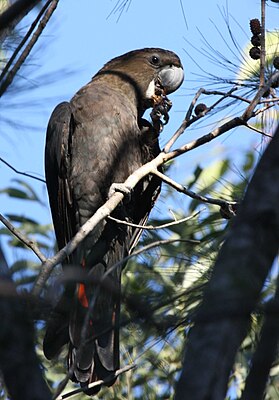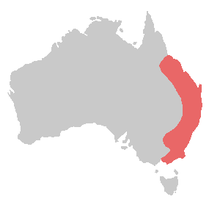Brown-headed Cockatoo
| Brown-headed Cockatoo | ||||||||||
|---|---|---|---|---|---|---|---|---|---|---|

Brown-headed Cockatoo, male, working on an allocasuarina cone. |
||||||||||
| Systematics | ||||||||||
|
||||||||||
| Scientific name | ||||||||||
| Calyptorhynchus lathami | ||||||||||
| ( Temminck , 1807) |
The brown-headed cockatoo ( Calyptorhynchus lathami ) is a species of parrot whose occurrence is limited to Australia. Overall, brown-headed cockatoos are not threatened as a species. The population living on Kangaroo Island and thus isolated from the rest of the population, which some ornithologists classify as an independent subspecies, comprises only around 100 individuals.
In their area of distribution, brown-headed cockatoos show a close connection to Allocasuarina trees. Where these trees have disappeared due to tree clearing, these cockatoos have meanwhile also disappeared. Due to this dependence on a few food plants, the brown-headed cockatoos are considered food specialists. Brown-headed cockatoos are widespread, but have always been relatively rare birds in their range. The relatively low availability of food resources plays a role here.
Appearance
Brown-headed cockatoos reach a body length of 48 centimeters and are thus the smallest species of the black cockatoo . They weigh between 420 and 500 grams. Because of their sexual dimorphism , which is relatively conspicuous for black cockatoos , they are placed in a subgenus together with the Banks black cockatoo .
Brown-headed cockatoos have dark soot-brown body plumage. It turns into a brown-black on the under tail-coverts. The feather bonnet characteristic of cockatoos is not very well developed in brown-headed cockatoos. The back and wings are black. The wings of the hand shimmer slightly brown-green. As is characteristic of all black cockatoos, their outer tail feathers have a cross-band that differs greatly from the color of the rest of the tail feathers. The color of this crossbar is bright red in males. In females, the crossbar of the control feathers is washed out yellow and broken up by thin, black horizontal stripes. However, with increasing age of the female, this distinguishing feature from the male is less pronounced. In addition to the color of the crossbar, the sexes can also be distinguished by the color of the beak. Males have gray beaks, while that of the females is more horn-colored. The most striking distinguishing feature from the male, however, are the isolated, either completely yellow or yellow-lined feathers on the head and neck. Their number is individually different. Some females have few yellow feathers. In others, the yellow feathers form large areas of color.
Young brown-headed cockatoos also have yellow feathers on the upper and lower wing-coverts. They have pale yellow feathers on the sides of their heads. The beak is horn-colored. The cross band of the outer control feathers is colored like the female. The black horizontal stripes that run through this crossbar are a little more noticeable than in adult females.
Brown-headed cockatoos are slow fliers and are characterized by their wingbeats that are less sweeping than other black cockatoo species. They cover longer distances at great heights. For shorter distances, they prefer to fly in the middle to upper vegetation layer. During the flight they screech tarr-red .... tarr-red or more quietly criie-iii .... criie-iii .
Brown-headed cockatoos are very similar in appearance to the Banks Black Cockatoos . In both species, the males have red transverse bands on the outer control feathers. Since both types of cockatoo are usually observed in pairs, the yellowish spotted head of the female brown-headed cockatoo is usually used to distinguish the two types. The two types can also be distinguished by their voice.
distribution and habitat
Brown-headed cockatoos occur in eastern Australia from northeast Queensland to east Victoria . An isolated population lives on Kangaroo Island, an island off the south coast. Their habitat is the mountainsides of the Great Dividing Range , a mountain range that stretches from the Cape York Peninsula to the southeast of Victoria.
Brown-headed cockatoos occur exclusively in the temperate climate zone of the Australian continent. Within their habitat of the Great Dividing Range, they inhabit coastal forests of the lowlands, mountain forests, semi-arid savannahs, gallery forests along watercourses and adjacent farmland. Unlike other Black Cockatoo species, they avoid urban habitats. Basically, it can be assumed that brown-headed cockatoos are in the vicinity of allocasuarinas . These trees are their main food crop.
In their distribution area close to the coast in southeast Australia, brown-headed cockatoos are probably resident birds , but they have very large action areas, in the center of which the nesting cave is located. Periodic migrations can be imagined in the peripheral regions of their range, such as in New South Wales. Non-breeding brown-headed cockatoos as well as young birds nomadize here occasionally also undirected in order to use the mostly scattered food resources.
Behavior and food
Brown-headed cockatoos are relatively rarely seen in flocks. Mostly it concerns special places such as water holes or an allocasuarina thicket with a rich set of seeds. It is more characteristic of brown-headed cockatoos that they stay in small family groups consisting of a pair and a young bird. Even with Brown-headed Cockatoos, which appear in flocks, the family group can be clearly identified as a sub-unit.
Unlike the rest of the black cockatoos, brown-headed cockatoos come to the ground relatively rarely. Most of the time they only do this to take in water from water holes. They spend most of the day in the Allocasuarina trees, where they bite the cones with a loud and audible click to get to the seeds. Other food only plays a subordinate role. You have specialized in plants that provide very nutritious seeds. Their specific beak shape is an adaptation to this main food. When eating, the individual cone is bitten off, turned upside down and held in the left foot. The stem is removed. Then the cone is chewed in the beak and the loosened seeds are separated from the rest of the material with the tongue and then swallowed. The bitten cones then fall to the ground. On average, the brown-headed cockatoos need one minute to bite into a seed cone. Breeding birds need around 140 cones every day. By contrast, non-breeding cones have around 70 cones per day.
If there are not enough casuarina seeds available, brown-headed cockatoos temporarily feed on the seeds of the eucalyptus trees, the acacias and the seeds of the Angophora intermedia .
Reproduction
Similar to the other black cockatoos, the courtship repertoire of the brown-headed cockatoos is limited to a few courtship gestures. Males strut towards the female with an erect hood and a tense posture as well as spread control feathers and bow while doing so. They are seasonal breeders. In most of their range, the breeding season falls from March to August. On Kangaroo Island, brown-headed cockatoos occasionally start the breeding business as early as February.
Brown-headed cockatoos are cave-breeders that mostly use caves in the branches and trunks of eucalyptus trees as nesting holes. The breeding caves are on average at a height of 10 to 20 meters above the ground. The caves have an average diameter of 22.5 centimeters and a depth between 60 and 90 centimeters. Females defend a breeding area of about 30 meters around the breeding cave from other species. Since the supply of suitable nesting caves is limited, brown-headed cockatoo nesting caves can even be found in the same tree. In these cases, however, there will be fights between the females if they enter the nest holes at the same time.
The clutch of the brown-headed cockatoo consists of only one egg. Pair feeding, in which the male chokes out food for the female, has already been observed in brown-headed cockatoos. This is a relatively rare behavior for cockatoos. The females breed on average for about 30 days. Brown-headed cockatoo chicks fled approximately 90 days after hatching. They then stay in close association with the parent birds. The longest observed period of time during which a young bird remained with the parent birds was 443 days. It is likely that brown-headed cockatoos do not breed every year.
Systematics
The genus Calyptorhynchus or Black Cockatoo is characterized by large and powerful beaks. The genus is divided into two sub-genera based on the different beak shapes and the clear differences in sex dimorphism. Most species are assigned to the subgenus Zanda . The Banks Black Cockatoo belongs to the subgenus Calyptorhynchus together with the Brown-headed Cockatoo . Both species show a very pronounced sexual dimorphism. Adult males are pure black with a red tail band. The females as well as the not yet sexually mature young birds have yellow to orange-red colored tail bands. Both species are characterized by a very broad beak. Further characteristic features of this subgenus are the squeaking feed-bed noises of the boys and the lack of noises when swallowing the food.
The number of subspecies is debatable. Some ornithologists distinguish three subspecies. In the opinion of the ornithologist Joseph M. Forshaw , who specializes in Australian parrots , the distinguishing features between the subspecies mentioned are very small and are limited to body size and beak shape. Above all, he doubts whether the Kangaroo Island Brown-headed Cockatoo is justified as a subspecies.
| subspecies | Distribution area | Distinguishing features of the individual subspecies |
|---|---|---|
| C. l. lathami , nominate form | The distribution area extends from the east of the Australian state of Victoria over the east of New South Wales to the southeast of Queensland . | The nominate form is the largest subspecies. |
| Kangaroo Island Brown-headed Cockatoo
( C. l. Halmaturinus ) |
The subspecies is now only found on Kangaroo Island . It used to be widespread on the adjacent mainland. | According to Joseph Forshaw, this subspecies can hardly be distinguished from a larger beak apart from the nominate form |
| Queensland Brown -headed Cockatoo ( C. l. Erebus ) | East and Northeast Queensland | Very similar to the nominate form, but with a smaller beak. |
Keeping in human care
Brown-headed parrots are outspoken food specialists and are rarely kept in human care. The ornithologist Dieter Hoppe , who specializes in parrots, reports that if the cockatoos are switched to sunflower seeds, maize, shiny seeds and other types of food, their beaks are deformed. The world's first breeding was achieved in 1954 by an Australian owner.
supporting documents
Individual evidence
- ↑ L. Joseph: The Glossy Black Cockatoo on Kangaroo Island. In: Emu. 82, 1982, pp. 46-49.
- ^ Forshaw, p. 122 and p. 123.
- ^ Forshaw, p. 123.
- ↑ Hoppe, p. 90.
- ^ Forshaw, p. 130.
- ↑ a b Hoppe, p. 91.
- ↑ a b Forshaw, p. 125.
- ^ Forshaw, p. 29.
- ↑ a b Hoppe, p. 92.
- ^ Forshaw, p. 132 and p. 133.
- ^ Forshaw, p. 134.
- ↑ a b Forshaw, p. 135.
- ^ Forshaw, p. 136.
- ^ Forshaw, p. 66.
- ^ Forshaw, p. 104.
- ^ J. Courtney: The juvenile food-begging calls, food-swallowing vocalization and begging postures in Australian Cockatoos . In: Australian Bird Watcher . tape 16 , 1996, pp. 236-249 .
- ^ R. Schodde, IJ Mason, JT Wood: Geographical differentiation in the Glossy Black Cockatoo Calyptorhynchus lathami. (Temminck), and its history. In: Emu. 93, 1993, pp. 156-166.
- ↑ Hoppe, p. 93.
literature
- Joseph M. Forshaw , illustrated by William T. Cooper: Australian Parrots. 1st German-language edition. Volume 1: Cockatoos and Lories. Arndt-Verlag, Bretten 2003, ISBN 978-3-9808245-1-4 .
- Dieter Hoppe : Cockatoos - way of life, keeping and breeding. Eugen Ulmer Verlag, Stuttgart 1986, ISBN 3-8001-7155-4 .
Web links
- Calyptorhynchus lathami inthe IUCN 2013 Red List of Threatened Species . Listed by: BirdLife International, 2012. Retrieved December 26, 2013.

